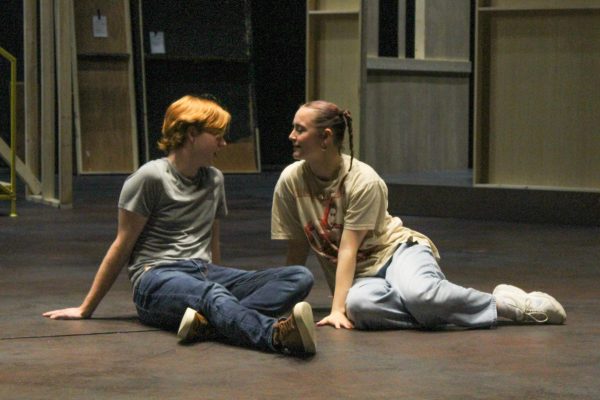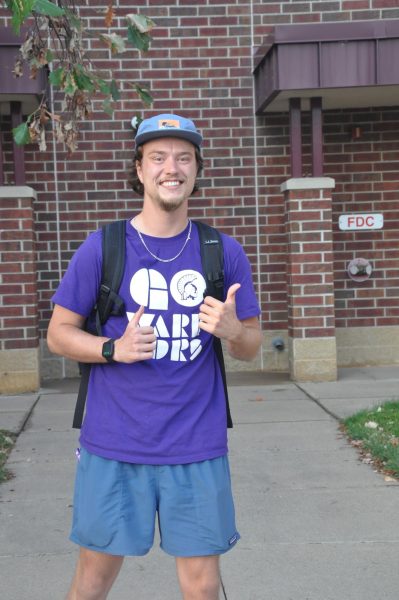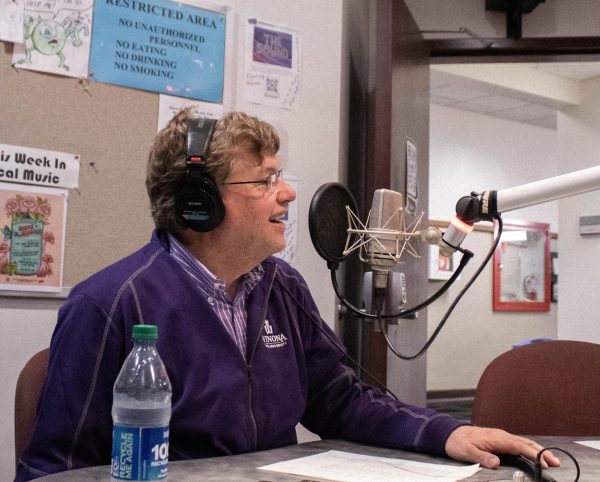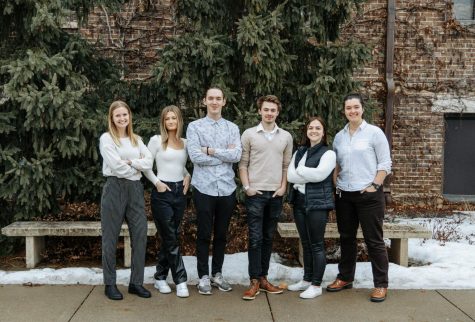Security, sheriff’s department simulate active shooter
March 29, 2017

Cheney Mason / Winonan
Bystanders in Minné Hall waited as Deputy John Hazelton held a gun, ready to fire.
The blank shots, loud and booming as if the gun were full of real bullets, were fired during the ALICE Active Shooter Response Training on the afternoon of Sunday, March 26.
“It definitely makes you think if it was a real situation what you would do,” junior Molly Rossbach said after the simulated gun shots, “It definitely makes your stress level go up, especially when you hear the gun shooting.”
The purpose of the blank shots of the gun was to not only make the situation seem more real and increase stress levels, it was also so students could hear what it sounded like.
“Different guns sound different in different buildings,” Hazelton said.
The acronym ALICE stands for Alert, Lockdown, Inform, Counter and Evaluate and is a set of strategies aimed at increasing the chances of someone surviving during the event of an active shooter.
The training began in room 103 in Minné Hall with a discussion from the Director of Winona State University Security, Chris Cichosz, Hazelton from the Winona County Sheriff’s Department, Investigator Josh Squires and Winona State Security member David Baertschi, who are all certified ALICE instructors.
According to Cichosz, the training gives trainees different options for survival.
“ALICE is giving you tools and options for stressful situations you are confronted with,” Cichosz said. “ALICE is not linear. It’s free flowing, and it changes because you could alert and then evacuate or even just evacuate.”
Cichosz added ALICE is recommended by high U.S. safety departments, such as the Department of Homeland Security, the New York Police Department, as well as the United States Department of Education.
This program has trained 3,280 police and law enforcement departments, 3,700 K-12 school districts, 900 higher education institutions, 1,700 businesses, 600 government agencies and is continuously growing.
The course on Saturday, March 25 and Sunday, March 26 at Winona State taught students proper steps to take in the event of an active shooter situation.
“You have to stay calm in a high stress situation,” Cichosz said. “That’s easier said than done, but take a deep breath.”
Cichosz said those involved in hosting the event hope to hold many more trainings over the summer as well as next year. He said 163 participants registered and around 75 to 80 showed up to the four trainings throughout February and March.
“I think it’s a good first step,” Cichosz said.
After the classroom portion of the most recent training, students and staff members were split into two groups, given a scenario and one volunteer was picked to mimic an “active shooter.”
Inside the rooms, tensions were high among the participants. University Advancement Development Assistant Liz Wilson said she could feel the nerves of her fellow trainees.
“I think we were all nervous,” Wilson said. “You learn something about yourself and how you really react to things like this.”
An air horn was set off to warn the two groups of participants the simulation had started. It was then when the students had to move quickly to turn off lights, close shades over windows, barricade doors and figure out what to do next.
“It really lets you know how quickly things happen and how vulnerable you are,” Wilson said. “And this was pre-planned, so we knew it was happening, whereas, if you didn’t, it would be different.”
Meanwhile, six nervous students sat in silence waiting for the air horn to sound allowing many to run for safety behind desks as well as scooping out items such as a belt to wrap around the door handle to secure the room.
University Advancement Administrative Assistant Peggy Walters said the training of her fellow participants were necessary for her group’s success.

“You really have to rely on those you are in the room with,” Walters said. “It was first, ‘how can we be safe and how can we be saved?’”
In the first scenario, people in the rooms were only supposed to be in “lockdown,” which means standing in the classroom with none of the doors barricaded.
Many people, like Walters, said they failed to hear the gunshots fired in the hallway.
“More times than not I didn’t hear the gunshots,” Walters said. “I think I reacted more to the people reacting in our room, and right away it was my first instinct was get the door secured and then figure out how can we be safe.”
Cichosz and Baertschi explained to the class the importance of taking action and doing what they can to survive these situations with steps such as being aware of surroundings and reporting suspicious activity, alerting other people that something is wrong, calling the police, locking down the room or area they are in, using resources to throw at the shooter or evacuating the area.
“There was something as simple as a stapler someone used in training and the door couldn’t be opened just because there was a stapler jammed under there.” Baertschi said. “You want to barricade, and be prepared. Don’t just turn off the lights and sit in a corner.”
The volunteer shooter for the simulation was told to use a spring loaded airsoft gun to shoot people from the waist down and had the pain level of a bee sting.
Student shooter volunteer Amy Gross said some of the trainees utilized what they learned during the simulation, with only a few mistakes.
“In room 104, I couldn’t really get in. They had it barricaded or locked, so I went down to room 103 and then came back and realized that 104 had another door,” Gross said. “So I came and went in that one. I saw some students by the wall and started shooting at them.”
Gross said when she came across a room where students were hiding, she had expected more people to be in there, yet some of the students had escaped out the second door and evacuated to safety.
“It’s a lot more difficult when there’s no lights,” Gross said. “I wish I would have found the light switch sooner rather than just shooting.”
Cichosz said these situations happen very fast as almost everyone in the class agreed after having been through the simulations.
“You can’t wait for law enforcement to save you,” Cichosz said. “You have to take it upon yourself to survive.”
After discussing previous school shootings, such as the ones that took place at Sandy Hook Elementary School and Virginia Tech, it was found the rooms that were barricaded and were able to take action were the ones with the least amount of deaths and wounded.
“As gruesome as it sounds, [the shooters] are looking for body count and numbers,” Cichosz said. “They aren’t going to spend time trying to get in barricaded rooms.”
This showed to be true during the scenarios at the ALICE training. The rooms that were barricaded and harder to get into were the ones where the people were generally unharmed.
Yet, tensions were still high for some volunteers.
“My biggest takeaway was how nervous I was before and actually how anxious I still am,” Walters said.
From a student perspective, Rossbach said she took away lessons and useful tips from the training and scenarios experienced during the three-hour long course.
“I know that in future situations I’m going to be looking and being a lot more aware than what I would have been before taking this.” Rossbach said.
Winona State has multiple resources for the safety of the campus including the Star Alert system, the BAIT team, which stands for Behavioral Assessment and Intervention, and the ALICE training program. The new program is something Cichosz said is universally beneficial for participants.
“This is something you can use forever,” Cichosz said. “Like riding a bike.”
By Cheney Mason




































































![“[Dr. Berg] you have done an amazing job of building this program and I have always been in awe at your ability to find resources in all sorts of nooks and crannies including your own pocket to bring to campus an amazing women’s history month program,” Dr. Hyamn said.](https://winonan.org/wp-content/uploads/2023/04/52844059083_5f6fb6176d_o-475x344.jpg)
